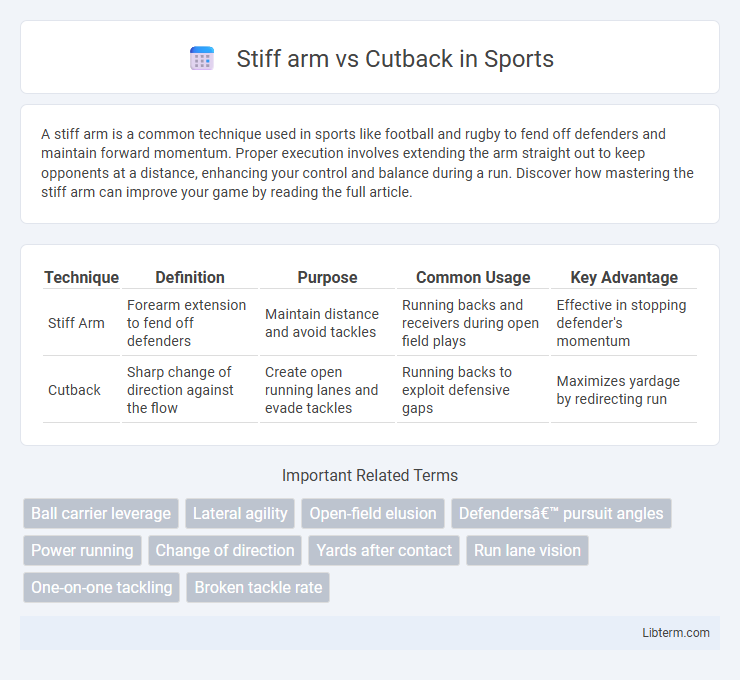A stiff arm is a common technique used in sports like football and rugby to fend off defenders and maintain forward momentum. Proper execution involves extending the arm straight out to keep opponents at a distance, enhancing your control and balance during a run. Discover how mastering the stiff arm can improve your game by reading the full article.
Table of Comparison
| Technique | Definition | Purpose | Common Usage | Key Advantage |
|---|---|---|---|---|
| Stiff Arm | Forearm extension to fend off defenders | Maintain distance and avoid tackles | Running backs and receivers during open field plays | Effective in stopping defender's momentum |
| Cutback | Sharp change of direction against the flow | Create open running lanes and evade tackles | Running backs to exploit defensive gaps | Maximizes yardage by redirecting run |
Introduction to Stiff Arm and Cutback Techniques
The stiff arm technique involves extending the arm to fend off defenders while maintaining speed and balance, crucial for breaking tackles and gaining extra yards. Cutback requires a sudden change of direction against the flow of the defense, exploiting gaps in pursuit angles to evade tackles and create running lanes. Both techniques are fundamental for ball carriers seeking to maximize yardage and maintain control under defensive pressure.
Understanding the Basics: What Is a Stiff Arm?
A stiff arm, also known as a straight arm, is a fundamental football maneuver where the ball carrier extends their arm to push away a defender, maintaining distance and preventing tackles. This technique requires precise timing and strong arm extension to effectively create separation without losing speed or control. Mastering the stiff arm enhances a player's ability to break tackles and gain extra yards during runs.
The Fundamentals of the Cutback Move
The cutback move in football involves a sudden directional change to evade defenders by sharply reversing the running path, requiring precise footwork and body control. Proper execution demands lowering the center of gravity, planting the inside foot firmly, and using lateral balance to create separation from the defender. Mastering the fundamentals of the cutback enhances agility and effectiveness in open-field running, making it crucial for ball carriers looking to extend plays.
Key Differences Between Stiff Arm and Cutback
The key differences between a stiff arm and a cutback lie in their technique and purpose during gameplay. A stiff arm involves a strong, extended arm to fend off defenders and maintain forward momentum, maximizing yards after contact. In contrast, a cutback is a sharp, sudden change of direction against the flow of the defense designed to exploit open lanes and gain additional yardage by avoiding tackles.
Situational Effectiveness: When to Use Each Move
The stiff arm is most effective in open-field situations where a runner faces a close tackler and needs to create space to break free. The cutback excels near the line of scrimmage or in tight running lanes, allowing the ball carrier to quickly change direction and exploit defensive gaps. Using the stiff arm against defensive backs or linebackers in pursuit enhances yardage, while the cutback is optimal for navigating through congested areas and avoiding tackles behind the line.
Technique Breakdown: Performing a Stiff Arm
Performing a stiff arm requires extending the lead arm fully while locking the elbow to create a barrier against the defender, effectively pushing them away to maintain separation. Proper hand placement is crucial, with the palm facing outward and fingers spread to maximize control and leverage during contact. Maintaining a low center of gravity and forward momentum enhances balance and power, allowing for efficient yardage gain when executing the stiff arm technique.
Mastering the Cutback: Essential Steps
Mastering the cutback in surfing requires understanding the shape and speed modulation of the wave while redirecting the board back toward the breaking section. Key steps include maintaining a low center of gravity, applying pressure on the heels to initiate the turn, and using the trailing arm for balance and control. Proper timing and weight distribution enable surfers to execute smooth, powerful cutbacks that maintain momentum and flow seamlessly into the next maneuver.
Pros and Cons: Stiff Arm vs Cutback
The stiff arm offers superior control and distance by keeping defenders at bay, making it effective in open-field tackles but can reduce maneuverability and leave runners vulnerable to multiple defenders. The cutback allows for quick changes in direction to exploit defensive gaps, enhancing evasion and yards after contact, yet it requires precise timing and agility, risking loss of momentum or tackles if poorly executed. Choosing between a stiff arm and cutback depends on a player's strength, speed, and the defensive setup they face.
Famous Players Known for Each Technique
John Elway and Aaron Rodgers are famous for their stiff arm technique, using it effectively to fend off defenders and extend plays. Barry Sanders and Eric Dickerson excelled in executing cutbacks with exceptional agility, often changing direction swiftly to evade tackles. Both techniques highlight distinctive skills that contribute significantly to a running back's or quarterback's evasion capabilities in football.
Training Tips to Improve Both Stiff Arm and Cutback
Enhance your stiff arm technique by practicing hand placement drills that emphasize extending your arm fully to keep defenders at bay while maintaining balance and forward momentum. For the cutback, focus on agility ladder exercises and cone drills that improve quick directional changes and lower body strength to execute sharp, controlled turns. Incorporate resistance band workouts and sprint intervals to build power and speed, critical for maximizing effectiveness in both the stiff arm and cutback maneuvers.
Stiff arm Infographic

 libterm.com
libterm.com